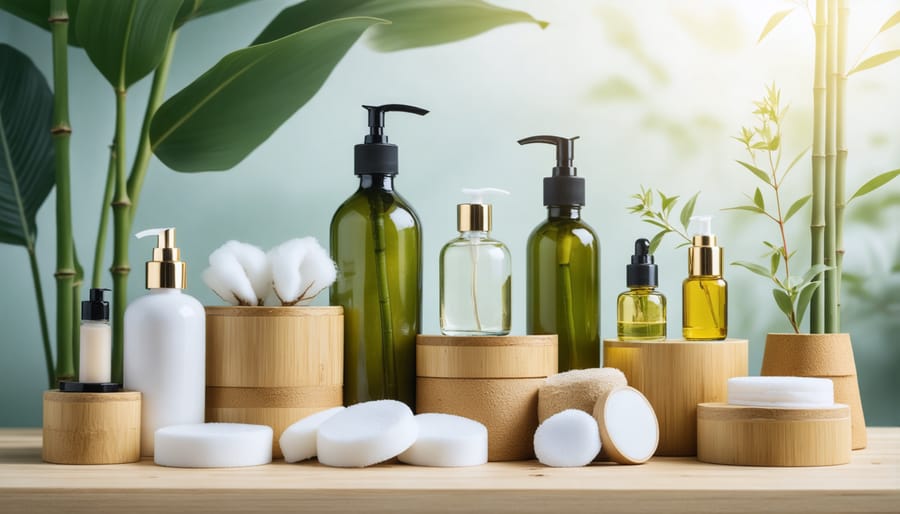
Transform your daily routine into an eco-friendly journey with simple, impactful changes that make a real difference. From your morning coffee to your evening wind-down, every choice creates ripples of positive environmental impact. Living sustainably isn’t about massive lifestyle overhauls – it’s about mindful decisions that add up to meaningful change.
Start with your kitchen: swap single-use plastics for reusable containers, compost food scraps, and choose locally sourced produce. In your bathroom, switch to plastic-free shampoo bars and bamboo toothbrushes. Your wardrobe can evolve with capsule collections featuring timeless, high-quality pieces that last for years rather than fast-fashion trends.
The beauty of sustainable living lies in its flexibility – you can adapt these practices to fit your unique lifestyle while making a genuine environmental impact. Whether you’re a busy parent, a young professional, or somewhere in between, there’s always room to incorporate earth-friendly habits that benefit both you and the planet.
Ready to discover how small changes can create lasting impact? Let’s explore practical, everyday examples that make sustainable living feel natural and achievable, without compromising on comfort or style.
Kitchen Sustainability Made Simple
Zero-Waste Meal Planning
Let me share a game-changing approach that transformed my kitchen habits: zero-waste meal planning. As someone who used to frequently discover forgotten produce hiding in my fridge, I’ve learned that the path to a sustainable and healthier diet starts with thoughtful planning.
Begin by conducting a weekly fridge inventory before shopping. Take photos of what you have – it’s like creating your personal grocery store catalog! This simple habit helps prevent duplicate purchases and ensures you use ingredients before they spoil.
Create a flexible meal plan that incorporates overlapping ingredients. For instance, if you’re buying fresh herbs for Monday’s pasta, plan Thursday’s quinoa bowl to use the remainder. Think of it as creating a ingredient story throughout your week.
Storage is crucial for extending food life. Invest in clear glass containers – they’re not just Instagram-worthy but help you see what’s available at a glance. Keep a “eat me first” box in your fridge for items nearing their prime. Pro tip: Store herbs like fresh flowers in water, covered with a reusable bag, and watch them last twice as long!
Get creative with leftovers – they’re not just next day’s lunch but ingredients for new meals. Those roasted vegetables from dinner? Blend them into tomorrow’s soup. Extra rice? Perfect for a quick stir-fry.
Remember, zero-waste meal planning isn’t about perfection – it’s about progress. Start small, perhaps with planning just three days ahead, and gradually build your confidence. Your wallet and the planet will thank you!

Eco-Friendly Kitchen Essentials
Making your kitchen more eco-friendly doesn’t have to be complicated or expensive. I remember when I first started my sustainable journey – it began with simply swapping out my plastic wrap for beeswax wraps, and I was amazed at how this small change made such a big difference in reducing my household waste.
Let’s start with food storage essentials. Replace single-use plastic containers with durable glass jars and containers, which not only look beautiful on your shelves but also last for years. Mason jars are perfect for storing dry goods, while glass containers with bamboo lids work wonderfully for leftovers and meal prep.
For cleaning, swap paper towels with reusable cloth alternatives. I keep a drawer of organic cotton cloths that I can easily wash and reuse. Swedish dishcloths are another game-changer – they’re super absorbent, washable, and completely compostable when they eventually wear out.
When it comes to cooking tools, opt for materials that stand the test of time. Cast iron pans and wooden utensils are not just sustainable choices; they actually make your food taste better! Bamboo cutting boards, stainless steel straws, and silicone baking mats are other must-haves that eliminate the need for disposable alternatives.
Don’t forget about coffee and tea routines. A French press or reusable coffee filter can replace disposable paper filters, while loose-leaf tea with a steel infuser is a wonderful alternative to tea bags. As for shopping, keep mesh produce bags and canvas totes handy for grocery runs.
Remember, transitioning to an eco-friendly kitchen is a journey. Start with what feels manageable and add more sustainable swaps as you go. Your future self (and the planet) will thank you!
Clean Beauty That Actually Works
Natural Skincare Swaps
Making the switch to natural skincare doesn’t have to be complicated or expensive. Before diving into these swaps, take time to determine your skin type to ensure the best results with these natural alternatives.
Let’s start with a gentle facial cleanser: mix raw honey with a splash of warm water for a natural antibacterial wash that won’t strip your skin. For toner, apple cider vinegar diluted with water works wonders in balancing skin pH. I personally noticed a significant improvement in my skin’s texture after making this simple switch.
When it comes to moisturizing, pure coconut oil or jojoba oil can replace conventional lotions. For those with oily skin, aloe vera gel provides lightweight hydration. One of my favorite discoveries has been using mashed avocado as a hydrating face mask – it’s like having a spa treatment right in your kitchen!
For exfoliation, mix ground oatmeal with honey and a splash of water to create a gentle scrub. Coffee grounds mixed with coconut oil make an excellent body scrub that helps reduce the appearance of cellulite while being completely biodegradable.
Remember to store your natural products in glass containers rather than plastic, and make small batches to ensure freshness. Start with one swap at a time, giving your skin time to adjust to each new ingredient. These natural alternatives not only benefit your skin but also reduce plastic packaging waste and exposure to synthetic chemicals.
Sustainable Beauty Storage
Let’s transform your beauty storage into an eco-friendly haven that Marie Kondo would approve of! I’ve discovered that sustainable beauty storage isn’t just about looking pretty – it’s about maximizing what you have while minimizing waste. One of my favorite solutions is repurposing glass jars from the kitchen to store cotton rounds and beauty tools. They look gorgeous on the bathroom counter and keep everything dust-free!
Consider investing in clear, reusable containers for your everyday products. This not only helps you see exactly what you have (goodbye, forgotten face masks!), but also prevents you from over-purchasing items you don’t need. I’ve found that bamboo organizers work beautifully for storing makeup brushes and skincare tools – they’re naturally antibacterial and look stunning on display.
For those sample-size products we all collect, try creating a designated “use-first” box. This simple system helps prevent products from expiring before you can enjoy them. Speaking of expiration, maintain a small whiteboard or label system to track when products need to be used by – this prevents waste and helps you plan your beauty routine more effectively.
Another game-changer has been switching to magnetic palettes for makeup. Instead of keeping individual plastic compacts, depot your favorite products into one reusable palette. This saves space and reduces packaging waste dramatically. For travel, opt for reusable silicone containers rather than buying travel-sized products each time.
Remember, sustainable beauty storage isn’t about perfection – it’s about making mindful choices that work for your lifestyle while reducing environmental impact. Start small by implementing one or two of these ideas, and watch how naturally the rest follows!

Daily Habits That Make a Difference
Morning Routine Revamp
Starting your day with sustainable choices can create a ripple effect of positive impact. I used to rush through my mornings without much thought, but after adopting some simple eco-friendly habits, my routine feels more intentional and earth-conscious.
Let’s start with your morning brew. Switch to a French press or reusable coffee filter instead of single-use pods or paper filters. Choose fair-trade, organic coffee beans stored in a glass container, and compost your grounds – they make excellent fertilizer for your plants!
In the bathroom, opt for a bamboo toothbrush and natural toothpaste in recyclable packaging. Replace disposable cotton rounds with washable ones for your skincare routine, and consider switching to bar soap and shampoo to eliminate plastic bottles. Keep a small basket of these reusable items neatly organized for easy access.
For breakfast, prepare overnight oats in a mason jar or enjoy fresh fruit with yogurt from returnable glass containers. Pack your lunch in reusable containers and a cloth napkin instead of disposable alternatives.
Before heading out, fill your reusable water bottle and travel mug. Choose natural-fiber clothing and air-dry your hair when possible to reduce energy consumption. These small morning switches might seem minimal, but they add up to significant environmental impact over time – and they’ll likely save you money too!

Shopping Smart
Making sustainable shopping choices doesn’t mean sacrificing quality or style – it’s about being mindful and intentional with our purchases. As someone who’s embraced a path to minimalism, I’ve discovered that smart shopping habits can significantly reduce our environmental impact while saving money.
Start by creating a shopping list and sticking to it – this simple practice prevents impulse purchases and reduces waste. When grocery shopping, bring reusable bags and containers for bulk items. Choose products with minimal packaging or recyclable materials, and opt for local, seasonal produce whenever possible.
For clothing and household items, consider second-hand options first. Many thrift stores and consignment shops offer high-quality pieces at fraction of the cost. When buying new, invest in durable, timeless items rather than following fast-fashion trends. Look for brands that prioritize sustainable materials and ethical manufacturing practices.
Before making any purchase, ask yourself: “Do I really need this?” and “Will this item last?” Consider borrowing rarely-used items from friends or joining local lending libraries. When shopping online, combine orders to reduce shipping packaging and carbon emissions. Remember, sustainable shopping isn’t about perfection – it’s about making better choices one purchase at a time.
Evening Wind-Down
As the day winds down, creating sustainable evening habits can help both the planet and your peace of mind. Start by switching off unnecessary lights and unplugging electronics that aren’t in use – those little standby lights actually consume energy! Instead of harsh artificial lighting, try using natural beeswax candles for a cozy atmosphere that’s better for air quality.
When it comes to evening cleaning, ditch the chemical-laden products for natural alternatives. I love mixing vinegar, water, and a few drops of essential oils for an all-purpose cleaner that works wonders. Keep a spray bottle of this mixture in your bathroom for quick wipe-downs, and you’ll reduce both plastic waste and harmful chemicals in your home.
For your nighttime self-care routine, opt for reusable cotton pads instead of disposable wipes, and consider switching to package-free soap and shampoo bars. One of my favorite discoveries was bamboo towels – they’re incredibly soft, naturally antimicrobial, and more sustainable than traditional cotton ones.
Before bed, take a moment to prepare for tomorrow. Set out your reusable water bottle, coffee cup, and shopping bags by the door. This simple habit ensures you won’t reach for single-use alternatives when you’re rushing in the morning. Finally, adjust your thermostat a few degrees lower during sleeping hours – it’s better for both your sleep quality and energy consumption.
Living sustainably doesn’t require a complete lifestyle overhaul overnight. As we’ve explored throughout this article, there are countless ways to make eco-friendly choices that suit your lifestyle and circumstances. Remember, every small change adds up to create a significant positive impact on our environment.
Start with what feels manageable – perhaps switching to reusable shopping bags or beginning a small herb garden on your windowsill. As these habits become second nature, you’ll find yourself naturally gravitating toward more sustainable choices in other areas of your life. I started my journey by simply bringing my own coffee cup to work, and now, three years later, I’ve transformed nearly every aspect of my daily routine.
The beauty of sustainable living is that it’s highly personal. What works for one person might not work for another, and that’s perfectly okay. Focus on the changes that align with your values and lifestyle, whether that’s composting, reducing plastic use, or supporting local farmers’ markets.
Remember, sustainable living isn’t about perfection – it’s about progress. Every time you choose a reusable alternative, opt for package-free produce, or repair instead of replace, you’re contributing to a healthier planet. Let’s support each other in this journey, share our successes (and lessons learned), and celebrate every step toward a more sustainable future.



